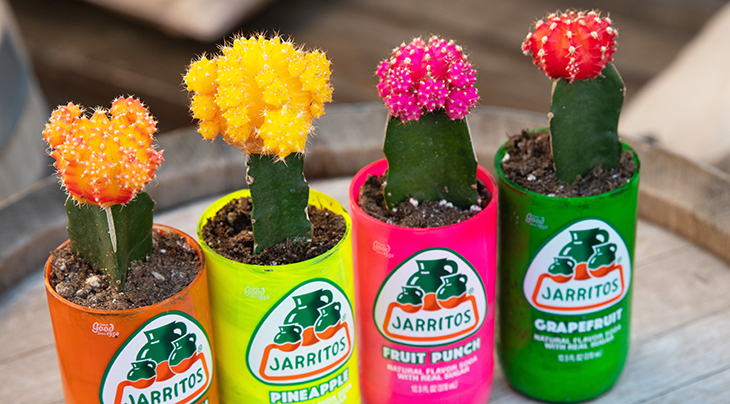Environmentally Friendly Home Improvement Projects
During the pandemic, millions of Americans decided to pick up their paint brushes, wrenches, screwdrivers, and power tools in an effort to make their houses more like the homes of their dreams.
 (Upcycling / Re-Purposed Jar Planters Photo: Jarritos Mexican Soda)
(Upcycling / Re-Purposed Jar Planters Photo: Jarritos Mexican Soda)
At the same time, many of us have become more aware of climate change and the need to lead sustainable lifestyles than ever before. In fact, research collected by the Pew Research Center shows that two-thirds of the adult American population believes that we need to do more to combat climate change.
If you’re considering a remodel, and are sick of waiting for change to come to you, then there’s good news: it’s easier than ever to take on an environmentally friendly home improvement project – hear are a few ideas and tips to get you started.
Big Projects
When it comes to home improvement, there are essentially two types of projects: tinker projects, and big renovations. Tinker projects are those fun little assignments like changing door knobs or painting a fun feature wall. Large-scale renovations take far more effort, time, and money.
To create an environmentally friendly home, you’re probably going to need to embrace some large-scale renovations. That’s because large-scale renovations are really where you’ll get the most bang for your buck. Here are the biggest changes you should consider.
- Solar panels
- Wind turbine
- Improved insulation
- Underfloor heating
- Improved / smart thermostat
- Energy-efficient appliances
Most of these changes will require an initial outlay of funds, but you will almost certainly recoup these costs over a few years as your home becomes more energy efficient and your bill is reduced.
Sustainable Materials
Nowadays, there are plenty of companies and brands that look “green” but, in reality, are not. This is called greenwashing, and it makes it difficult to identify a supplier that truly prioritizes sustainability. This means that you have to be extra vigilant when shopping online or in your favorite hardware store.
The easiest way to get around greenwashing is to recycle and reuse. There are almost always extra materials lying around your home which have been forgotten about or are simply underutilized. This might lead you to renovate tired-looking cabinet doors with fresh paint and new handles, or you might take an “upcycling” approach to home improvement.
Upcycling is a great way to use the things that come into your home in creative and aesthetically pleasing ways – it’s also great for your health. For example, you can easily turn empty glass jars into beautiful and practical terrariums. These terrariums give you space to grow small veggies and herbs that are good for your body and fit in well with the aesthetic of sustainability.
Interior Design
Environmentally friendly projects don’t have to look hodgepodge or shabby. However if it is your first time pursuing an environmentally friendly home improvement project, then you may need to embrace a more eclectic aesthetic while your skills improve.
The best way to improve your skills quickly is to discover an aesthetic or style that you resonate with, and follow it. At first, this will probably not yield the results you are looking for. But, over time, you’ll find that your efforts to create your own interior design elements will start to bring you a certain “look”.
If you’re lacking inspiration, it’s worth taking a look online at “green interior design”. You’ll find plenty of source material, most of which will be beyond the average person’s skills and budget. That said, you should try to “steal” one single viable element from a project you admire. This will give you a bit of direction and will help you stay inspired even if your initial effort’s don’t go to plan.
Community Outreach
Fighting climate change requires us to make a community effort. That’s because no single individual can do everything it takes to completely combat climate change. This means you need to get in contact with the community of climate activists that exists in your town or city.
One of the best trends in community climate activism currently is environmental remediation. This sounds rather technical, but all it means is that your community will invest time and effort into restoring natural spaces and cutting down on pollution. usually, these projects are spearheaded by environmental experts, who can guide you towards the best course for restoring your local, natural, area.
As an individual, you can connect with environmental remediation by gardening to make your outdoor space a more cohesive part of the wider natural ecosystem. You can do this by planting seeds in your lawn to create a wildflower meadow, or by putting out small water basins for birds and bees. By getting out in the garden, you’ll also naturally boost your immune system, and will benefit greatly from the time spent outdoors.
Conclusion
Tinkering away in our homes is one of life’s greatest pleasures. Nowadays, it’s worth considering how your home improvement can serve the environment too. You can do this by exploring alternative energy sources or by upcycling materials like glass and wood in order to create your perfect home.
*This article is for general informational purposes only. 50+ World does not endorse any product or service providers, nor does it receive remuneration from them. Obtain expert advice – financial, legal, medical, industry-specific, etc. – from qualified practitioners about your unique situation.*
